This is just a sample of the many
antique calculation devices we have sold.
Click link to see other
Past Sales Archive Pages on this Site.
We Buy Quality Office & Scientific Related
Antiques
Contact Us at
AntiqBuyer@gmail.com
Special Note Concerning Prices Seen Below:
Most prices seen reflect actual sale results from this website.
Prices seen are relatively recent or pieces that have
held their value and reflect what I believe to be current values.
On other pieces you will see no price, or a price range,
with or without an explanation. The reasons for that are discussed on the FAQ page.
Our current offering of Antiques for sale are at our sister Website Patented-Antiques.com.
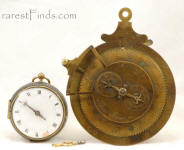 c. 1700
Pierre Fardoil Adding Machine & Watch / Time Piece
I am half owner of the
18th Century Pierre Fardoil Adder / Adding Machine and Fardoil Watch / Time
Piece pictured. I am selling my 1/2 share in this early Fardoil Adder. The other half owner is Peter Frei, an antique dealer based in Massachusetts.
Since I have started trying to sell my 1/2 share in the Fardoil Peter
Frei now claims we are not, and never were partners in the Fardoil. That is a
strange claim for him to make given our past history and communications
regarding the Fardoil. It also has the effect of him finally putting in
writing what his true intent has been.
c. 1700
Pierre Fardoil Adding Machine & Watch / Time Piece
I am half owner of the
18th Century Pierre Fardoil Adder / Adding Machine and Fardoil Watch / Time
Piece pictured. I am selling my 1/2 share in this early Fardoil Adder. The other half owner is Peter Frei, an antique dealer based in Massachusetts.
Since I have started trying to sell my 1/2 share in the Fardoil Peter
Frei now claims we are not, and never were partners in the Fardoil. That is a
strange claim for him to make given our past history and communications
regarding the Fardoil. It also has the effect of him finally putting in
writing what his true intent has been.Below is a condensed history regarding our partnership and the Fardoil Adder.
Approximately 10 years ago after buying the Fardoil Adder and timepiece from a private party as 50/50 partners, the Fardoil adder and Fardoil time piece were sent to the Breker auction in Germany where they "sold" for approx. $74,000. That "sale" failed after the winning bidder backed out for reasons explained later. The Fardoil Adder / Adding Machine and Fardoil Pocket Watch pictured here are the very same 2 pieces that were offered at the Auction-Team Breker sale. That auction write-up and result, with no mention that the sale failed, can be found online at Liveauctioneers.com/item/36708195_the-adding-machine-of-pierre-fardoil-c-1700.
Shortly after the failed Fardoil sale Peter Frei, in a fit of faux outrage, declared we were no longer friends over a situation concerning an antique sewing machine we were also 50/50 partners on. At that time he did admit, in writing, that we were partners in the Fardoil. He has alluded to that fact numerous times in writing since then.
Peter and I had been partners in several other technology-related antiques prior to having a falling out over that sewing machine. Here is a concise telling of the story about it. At an auction, Peter bought and I paid for the base of a Fancy Leg Florence sewing machine base that had no head. I later found and bought the missing head and sent that to Peter, basically completing the machine.
Peter then, without consulting or discussing with me, entered into an agreement with a 3rd party offering that dealer 50% to sell the sewing machine. That reduced me to a 25% junior partner. When I questioned that, Peter, in a fit of faux rage, declared we were no longer friends and that our partnership was over. Recently Peter completely rewrote the history of that event, claiming he sent just the base to Brekers Auction and we simply split the proceeds. That telling of the story was a complete factual fabrication. That is easily provable. There are more details and facets to this story that are irrelevant to this sale and do not need to be retold right now but I have, in written correspondence with Peter what happened that clearly shows what transpired.
NEW DEVELOPEMENTS: There have been new developments since I have begun to try to sell my 50% / half share in the Fardoil.
First, Peter Frei removed the ad for the Fardoil from his website where it had been listed for sale for appox. $74,000. When I wrote Peter inquiring why, asking if it had been sold, or what his intentions were, he did not respond. In addition to the ad for the Fardoil on my two websites I also ran an ad on eBay so that a broader audience would be able to view it.
Peter Frei complained, not to me, but to eBay and had that ad taken down. He then posted his own version of an "ad" which in reality was just a rant / personal attack in which he claimed we were not, and had never been partners, and further claimed that he is sole owner and had only offered to split the proceeds of the sale of the Fardoil with me out of the kindness of his heart. But now that I had upset him, I am no longer due or entitled to anything. In his own words "my generosity has its limits"
For the last 10 years we quietly tried to work with him to settle up for the Fardoil always fearing he would make that claim. Given his current actions it is now clear Peter has no intention of honoring our partnership and splitting the proceeds from the sale of the Fardoil. And now when I have finally gone public and am attempting to sell my share of the Fardoil he has lashed out with personal attacks and delusional claims of sole ownership.
I am still rightfully and legally half-owner of the Fardoil and owed half of the proceeds if, or when, the Fardoil is sold. For the last 10 years Peter Frei has masked his true intent, stalling and hedging, but he has now put in writing what his true intent is / has been and I believe has opened the door for a legal action to resolve a relatively simple question.
There is no question that I can prove my half ownership rights. I can also prove I paid for half of the 2 pieces and have never received any compensation. I can also demonstrate that Peter Frei's ownership claims and the related story have changed over time, flip-flopping around depending on circumstances or his mood. In other words he has demonstrated that he has little credibility by changing his story over time. My story, backed in writing, has not changed.
I am not a lawyer, nor in a position to begin any legal actions myself to assert a legal ownership claim, but if credibility and truth still matter in this current era of "fake news" we now live in, it would seem a legal claim in court has good probability of being successful.
Another important development is the French museum CNAM, who 10 years ago had expressed an ownership claim prior to the Breker auction which helped cause the failed auction, have recently expressed no interest or ownership rights in the Fardoil, even when offered my 1/2 share as a donation that would have given them a legitimate ownership claim.
Below is the history / background of this rare piece of calculation history and my interactions with Peter Frei since the failed auction so potential buyers can have a better understanding of the background and get a sense of what to expect, or develop a plan on how to proceed.
The Fardoil adder was bought in upstate NY prior to the Breker auction from a private party. The owners contacted me first and I made an appointment to go see it. They told me that the adder had been "found" in New York, and the now deceased "finder" had been a caretaker / custodian / groundskeeper / employee when he "found" it. The family told me they had had it appraised at Sotheby's or Christies auction house for approx. 5K. I offered to purchase it from them for the same amount in cash.
The family / sellers initially said no. Months later the owners called me and said they were ready to sell the Fardoil. Because I was back in CA at that point I called Peter and offered him a 50/50 partnership to go and get it. He agreed and went and purchased it. We split the cost 50/50. Peter later found and bought the Fardoil watch and we split the cost of that as well. I have never received any compensation for those monetary outlays.
Those are facts that are not disputable although in his current writings Peter has now attempted to rewrite history with a story line that is easily refutable. We had a history of similar "gentleman's agreements / deals" in the past. There was nothing unusual or out of the norm about those deals or this one. I believe that given his flip flopping changing story in regard to the Fardoil, and the sewing machine episode, Peter will have no credibility when confronted with his past written statements.
Peter handled consigning the Fardoil to Breker's Auction. Prior to the auction the French Musee des Arts et Metiers / CNMA expressed an ownership right and claimed their Fardoil adder was "lost", stolen, or otherwise disappeared from their collection when it was on display in the US during the 1939 New York World's Fair. The Breker auction failed after the CNAM cast doubt on the rightful ownership of the Fardoil and the Arithmeum Museum, who was the high bidder at the auction, backed out of the sale.
This Fardoil could be the only known example if it is the same one that the CNAM expressed an ownership right to prior to the Breker auction. After the auction failed to produce a sale Peter attempted to market the Fardoil to the underbidder and other parties. Later the CNAM made a relatively low offer, not to purchase the Fardoil, but rather as compensation for having found it and returning it. That offer was rejected.
The high bidder at the Breker auction for the Fardoil Adder had been Professor Korte from the University of Bonn. He was bidding to acquire it for the Arithmeum Museum in Bonn, Germany. My understanding is that Korte backed out from finalizing the Breker auction sale due to the CNAM claim that the Fardoil was rightfully theirs. Because of the controversy this created the underbidder also backed away when it was offered to him after the auction. The two Fardoil pieces were then returned to the consignors---myself and Peter Frei. Peter Frei now has possession of both pieces.
Then something akin to the storyline in Lord of the Rings began to unfold, and the "my precious" concept, much like with Gollum and his "my precious / the ring" in that story, began to take hold. Peter, despite saying he was ready to sell, and that he wanted to sell the Fardoil, could not bear to let the Fardoil go, or have it leave his hands.
The disclosure of these details is necessary because I want to insure there are no claims of non-disclosure or other problems down the road from a buyer or new partner in my half share. The attempts after the failed auction for Peter and I to settle up on the Fardoil also need be told so that potential parties are fully informed and can better formulate a plan of how to proceed with Peter.
After the failed auction, and over the next 10 years, Peter offered several proposals to resolve the Fardoil situation between us, all in writing and documented. Peter reneged on following through on every one of them. For the record, we will review some of Peter Fries' past proposals:
Immediately after the auction Peter wrote that if the high bidder or under bidder would not pay the original sale price it had brought at auction he would simply buy us out for 1/2 of the high bid, as we both felt it had not reached its full potential because of the French interference. He never followed through on that proposal, later claiming it was just a negotiation tactic.
Shortly after the auction Peter announced we would settle up over the Fardoil by having a private auction between us, with a third party holding the Fardoil until that process was complete. We agreed to that proposal. He later reneged on that proposal claiming he did not have enough money to proceed.
Peter next demanded we wait, and be patient, as the Fardoil was, in his words, "burned" and its value diminished by the French claims, and the failed auction.
In 2019, 5 years after the auction and after numerous requests by us to resolve the situation, Peter said to wait one more year to see if he could sell the Fardoil from his new website. In writing he said that if it did not sell from his website at the end of the 1 year period we would send it to auction again. He proposed that in writing and then reneged on that solution with no explanation, and just offered lame excuses about being busy, or having other irrelevant personal issues.
Peter next suggested we should name a price he could buy us out at, with the stipulation that he would need 6 months to gather the money, a proposal that was neither fair nor equitable, but in the interest of ending this ordeal we proposed selling our half interest to him for $18K --- approx. 25% of the original sale price of $74K it had reached at the Breker auction. $18K equated to approx. 50% of what we were due had the auction succeeded---a fair and reasonable offer to resolve this.
In writing Peter rejected that offer outright and said he would never pay that amount. He offered no meaningful counter or further discussion. That was over 2 years ago, much longer than the 6 months he said would be needed to raise funds to buy us out, once again reneging on a proposal he himself put forward.
Most recently in Dec of 2024 we suggested listing it for sale on our own two websites, Patented-Antiques.com, and AntiqBuyer.com, at a lower price, to give it more exposure, and to enhance its desirability and value. To do that we needed to discuss a price beforehand that we could all agree to. Peter declined to discuss a lower price and then hours later wrote that he alone would decide if he would agree to a lower price---AFTER I found a buyer---a stupid and unworkable proposal not worth discussing further, and mentioned here only to illustrate the absurdity and his "my precious" attitude.
We next sent him a demand letter outlining his prior proposals as outlined above, and demanded he act on one of them or I was going to try a new approach, that being selling my 1/2 share, or donating it to the French so they would have a legitimate legal claim of ownership that they could pursue. He responded, and I paraphrase, Good luck with that, and stopped all further communication.
After that we decided to proceed with the plan to sell our 1/2 share, or take on a new partner in our 1/2 share / half interest in the Fardoil, or donate our half share to an interested party with just a few conditions or caveats. Bottom line, at this point, I am willing to sell my interest in the Fardoil for nothing more than a small earnest money deposit. I am simply looking for a qualified and acceptable party to make a reasonable proposal or propose a course of action to pursue that will rectify the situation. With that relatively low dollar amount as a baseline there is a lot of room for a qualified and interested party to add an important piece to their collection for a very small cash outlay, after a positive resolution.
I will sign an acceptable agreement drawn up by the new partner, their lawyer, or other representative. If the French / CNAM want to reconsider their ownership position and establish a legitimate 1/2 ownership to the Fardoil I will still extend this offer to them as well.
This proposal for my half interest in the Fardoil would be a great deal for the right person or entity who thinks they can better deal with Peter Frei and somehow force a sale or close the deal. Just think, a documented 1/2 ownership in a rare probably one-of-a-kind and unique piece of calculation history for a fraction of its potential value!
Click for Pic
Click for Pic
Click for Pic
Click for Pic
Click for Pic
Click for Pic
Click for Pic
Click for Pic
Click for Pic
Click for Pic
Click for Pic
Click for Pic
Click for Pic
Click for Pic
Click for Pic
Click for Pic
Click for Pic
Click for Pic
Click for Pic
Click for Pic
FARDOIL
Fine . . . . . . $1,000.00 . . . . . Earnest Deposit
To Order Email: patentedantiques@gmail.com
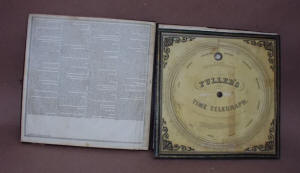 Fullers Computing Telegraph Calculator
w/ Palmers Computing Scales It is no wonder that America was
the leading power during the industrial revolution. They had people designing,
patenting, and introducing calculation devices like this one. This unusual
calculation device
Fullers Computing Telegraph Calculator
w/ Palmers Computing Scales It is no wonder that America was
the leading power during the industrial revolution. They had people designing,
patenting, and introducing calculation devices like this one. This unusual
calculation device
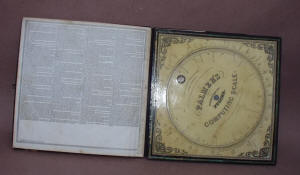 was light years ahead of the competition
and probably led to the introduction of many other new products and
ideas. The Palmer scale says it was first patented in the 1840's, and I
guess after Mr. Fuller improved on it he included it with his own
version of a circular slide rule. Luckily he had the foresight to
include with it a booklet of operating instructions The opening blurb
in the instructions claims this is "The Great Master Key Rule by Which
All Problems are Instantly Solved. I am not really sure if it could
have solved Bernie Madolf's problems.
was light years ahead of the competition
and probably led to the introduction of many other new products and
ideas. The Palmer scale says it was first patented in the 1840's, and I
guess after Mr. Fuller improved on it he included it with his own
version of a circular slide rule. Luckily he had the foresight to
include with it a booklet of operating instructions The opening blurb
in the instructions claims this is "The Great Master Key Rule by Which
All Problems are Instantly Solved. I am not really sure if it could
have solved Bernie Madolf's problems. The entire package is in very nice condition, and they are rarely seen in this nice condition any more.
Excellent . . . . .$795.00 SOLD!
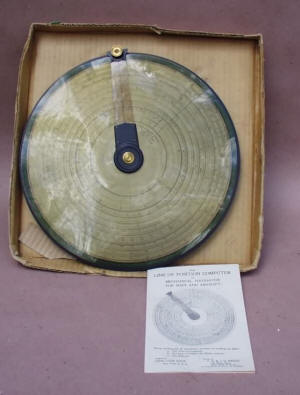 Poor's Line
of Position Navigation Computer This is a
rare and interesting navigation related calculator. There are a couple of
references on Google about it lamenting the fact that so few are known, and that
only pictures of it can be found in a book by the inventor Charles Poor.
The face is marked Pat applied for, and it is not known if one was ever granted
Poor's Line
of Position Navigation Computer This is a
rare and interesting navigation related calculator. There are a couple of
references on Google about it lamenting the fact that so few are known, and that
only pictures of it can be found in a book by the inventor Charles Poor.
The face is marked Pat applied for, and it is not known if one was ever grantedThis calculator is in like new condition with it original box. The box has seen better days and the corners are torn and weak. The instrument measures approx 12" dia. and the base is cast aluminum. The instructions are present and in very nice condition. It says it is a mechanical navigator for use on ships or aircraft. At the bottom in addition to the inventor designers name, the name T.S. & J. D. Negus is given as the seller. This was a well known outfit that dealt in all manner of navigational and nautical related devices.
Good+ . . . . $1295.00 SOLD!
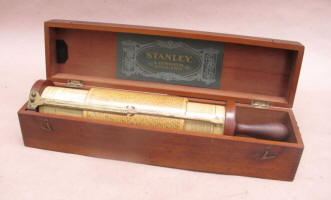 Stanley
Fuller / London England / Spiral Calculator / Sliderule
This Stanley Fullers Spiral Calculator / Slide rule is in nice condition.
This is an example of a calculator that is getting harder and harder to
find. They were first introduced in the 1880's. At first they were made
and offered by Stanley of London a well known firm that also made the famous
Thatcher calculator, and other surveying or engineering related
instruments. Later on K & E bought the rights and offered them until the
end of production in the early 70's.
Stanley
Fuller / London England / Spiral Calculator / Sliderule
This Stanley Fullers Spiral Calculator / Slide rule is in nice condition.
This is an example of a calculator that is getting harder and harder to
find. They were first introduced in the 1880's. At first they were made
and offered by Stanley of London a well known firm that also made the famous
Thatcher calculator, and other surveying or engineering related
instruments. Later on K & E bought the rights and offered them until the
end of production in the early 70's.The serial #'s numbers on the brass scale are 6900 -37. I believe that indicates it was made in 1937. It has the brass external mount feature so that the slide rule can mount for use on the outside of the box, but the mounting bracket itself is missing. The box is pretty nice, and is mahogany. It has a finger joint design in the corners. It has a nice green Stanley label inside the top. It is in overall good condition noting the remnants of another label or sticker on the outside top.
The inner scales are very nice. It has the typical scales and charts found on these type one model calculators, and the outer scale has the typical light brown tint to it. The scales, both in and out are in very nice condition noting just a few minor dings. The short pointer is marked Fuller Calculator, and Made in England. The long cursor in addition to having the date and serial number is graduated along one edge. A nice piece in outstanding condition.
Good + . . . . . $300 - $500 SOLD!!
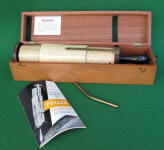 Fuller Spiral Slide Rule / Calculator
The condition of this
Fuller slide rule is
like new / mint and came from the original owner. These slide rules
were produced in England by the W. F. Stanley Co. The Fuller Circular
slide rule was first
developed and introduced in the 1870's.
Fuller Spiral Slide Rule / Calculator
The condition of this
Fuller slide rule is
like new / mint and came from the original owner. These slide rules
were produced in England by the W. F. Stanley Co. The Fuller Circular
slide rule was first
developed and introduced in the 1870's. The serial # on this unusual circular drum style slide rule is 13643 /70 dating it from 1970 and very close to the end of their production nearly 100 years later. It has been suggested in online write-ups that no more than 14,000 were made during their entire production span. Production of this slide rule was very limited by this period and this example is one of the last few hundred made when production ceased in the early 1970's. There were several different models produced and offered over the years. This style would be referred to as the type 1. Over the course of production different US companies like K & E and Dietzgen offered this rule as part of their line. This one is just marked Stanley / England.
The mahogany box is like new. The original instructions are included. The top and bottom of the rule are Bakelite and chip, crack or damage free. The brass rod to mount it to the box for convenient use is present. This rule is essentially new and unused. It will make for a great addition and marks the end of an era with the introduction of electronic calculators which made the obsolete and yet created a fine collectible. A classic!!
Fine + . . . . . SOLD!
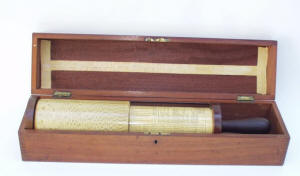 Fuller
Spiral Calculator by Stanley This
is an earlier model than the one above. It does not have the external
mount like the one above as the earliest models did not offer that feature.
The number on the brass scale is 109 and that number is repeated on the base
of the scale. I assume that is the serial # which would date this pretty
early in the scheme of things. There are no tears to the scales
and they are pretty nice on both the inner and outer drum. There
is some very minor spotting to the scales, but the overall condition is very
nice. There is a tight crack in the box top as can be seen, and there
is an early repair to it that adds a degree of character to this interesting
and early calculator. A nice piece in overall very nice condition.
Fuller
Spiral Calculator by Stanley This
is an earlier model than the one above. It does not have the external
mount like the one above as the earliest models did not offer that feature.
The number on the brass scale is 109 and that number is repeated on the base
of the scale. I assume that is the serial # which would date this pretty
early in the scheme of things. There are no tears to the scales
and they are pretty nice on both the inner and outer drum. There
is some very minor spotting to the scales, but the overall condition is very
nice. There is a tight crack in the box top as can be seen, and there
is an early repair to it that adds a degree of character to this interesting
and early calculator. A nice piece in overall very nice condition.
Good . . . . . SOLD
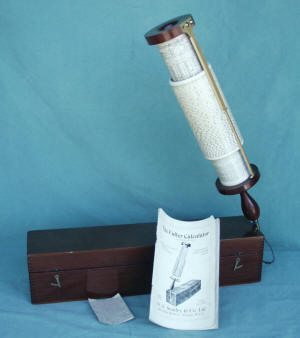 Stanley
Fuller Spiral Calculator / Sliderule This is
a super nice condition example. The numbers on the brass scale are 5968 -28.
I am not sure where that would put this date wise, but it is an later model with
the brass mount feature that the slide rule can mount to for use. There is
a hairline crack as can be seen in one of the pics in the wood frame, but it is
just a line in the wood. There is no damage, movement, or looseness.
The instructions are included as well. The John Davies label inside the lid
must be from the distributer, who specialized in Mining supplies as well as surveying
instruments and more. That label mentions 1933, but it is unclear in what
regard. A nice piece in outstanding condition.
Stanley
Fuller Spiral Calculator / Sliderule This is
a super nice condition example. The numbers on the brass scale are 5968 -28.
I am not sure where that would put this date wise, but it is an later model with
the brass mount feature that the slide rule can mount to for use. There is
a hairline crack as can be seen in one of the pics in the wood frame, but it is
just a line in the wood. There is no damage, movement, or looseness.
The instructions are included as well. The John Davies label inside the lid
must be from the distributer, who specialized in Mining supplies as well as surveying
instruments and more. That label mentions 1933, but it is unclear in what
regard. A nice piece in outstanding condition.
Excellent . . . . . SOLD!
 Stanley
Type 2 Fuller Spiral Calculator / Sliderule
This is a nice condition example of a very hard to find variation of a
Fuller / Stanley slide rule calculator. The numbers on the brass scale are
5836 -27. I believe that would date it from 1927. The finger joint
mahogany wooden box has a Stanley paper label in the top, as well as a tag,
from I assume, the factory it was being used in. I am not sure what the
name of that company was, but the tag says it is from the aircraft division
and 54 over 14690. The box is OK noting one latch is missing, and there are
some paint spots on the top. It does have the mounting bracket on the end
of the box, and the proper bracket to mount this calculator is in the box.
Stanley
Type 2 Fuller Spiral Calculator / Sliderule
This is a nice condition example of a very hard to find variation of a
Fuller / Stanley slide rule calculator. The numbers on the brass scale are
5836 -27. I believe that would date it from 1927. The finger joint
mahogany wooden box has a Stanley paper label in the top, as well as a tag,
from I assume, the factory it was being used in. I am not sure what the
name of that company was, but the tag says it is from the aircraft division
and 54 over 14690. The box is OK noting one latch is missing, and there are
some paint spots on the top. It does have the mounting bracket on the end
of the box, and the proper bracket to mount this calculator is in the box. As for the rule itself, the scales are pretty nice with just a few small dings here and the typical yellowing the paper scales develop. There is a hairline crack in the top wooden donut as can be seen in one of the pics. It is just a line in the wood, there is no damage, movement, or looseness. There is also some minor staining, dirt and chipping of the paper at the top and bottom of the outer cylinder. The short pointer is marked Fuller Calculator with Scales of Sines & Logs Made in England. This is what makes this model so unusual. One can see the difference immediately on the inner scale as there are none of the typical tables or equations usually seen. This inner scale is made up of 2 sets of scales from top to bottom. A rare piece in nice condition.
Good + . . . . . SOLD!
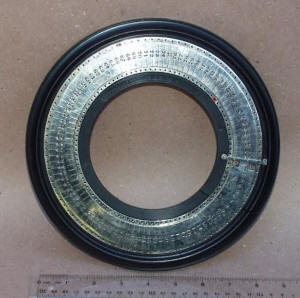 Gordon's
Addometer / Calculator This is an interesting, early, and
rare adder. It is marked on the inside ring "Gordon's Addometer / Patent
Applied For". The circular body is made of Gutta Percha type plastic material.
There is a crack in it from shrinkage. It is stable and the calculating
rings can still be rotated. The cover is a nickel plated non- magnetic
material like brass. I believe unusual circular adder dates from the last
quarter of the 19th century, and perhaps as late as the turn of the century.
Gordon's
Addometer / Calculator This is an interesting, early, and
rare adder. It is marked on the inside ring "Gordon's Addometer / Patent
Applied For". The circular body is made of Gutta Percha type plastic material.
There is a crack in it from shrinkage. It is stable and the calculating
rings can still be rotated. The cover is a nickel plated non- magnetic
material like brass. I believe unusual circular adder dates from the last
quarter of the 19th century, and perhaps as late as the turn of the century.
A Google search turns up just one reference for the Gordon Addometer from a German site listing the name but there is no patent info or other info at that site. Most Addometers are much later than this and there is plenty of info on those. A Google Patent search turns up nothing for Gordon Addometer. I tried for over an hour to find something similar and I looked at a lot of other devices called addometers and perhaps the reason is that this design was an infringement and was never granted a Patent. I am not sure.
I do have a bit more information from the owner. This is one of just 4 of these that was found in an attic in New York near the New Jersey border about 20 years ago. The parties in that original transaction surmised that the inventor had just a few of these made as pre-promotional examples, but that something then transpired that stopped the patent process and any further manufacture or development. When these were found two were sold privately, and one was placed in the German Breker Technology Auction, where it sold in the 4K range. This is the last one that remains, and when this one goes that is the end of them.
Opportunity knocks.
Good . . . . .$3250.00 SOLD
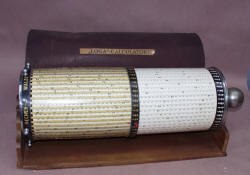 Loga
Drum
Calculator / Sliderule This large cylindrical
slide rule / calculator is a Swiss idea that was produced just after the turn of
the century up until about 1920. They came in a few different
configurations and with different bases or covers. This ones instructions
are missing, but the rule is otherwise pretty nice. The cover has a couple
dents in it, but is OK. It measures approx 18" long and I believe is
the largest model offered.
Loga
Drum
Calculator / Sliderule This large cylindrical
slide rule / calculator is a Swiss idea that was produced just after the turn of
the century up until about 1920. They came in a few different
configurations and with different bases or covers. This ones instructions
are missing, but the rule is otherwise pretty nice. The cover has a couple
dents in it, but is OK. It measures approx 18" long and I believe is
the largest model offered. Good+ . . . . .$795.00 SOLD!
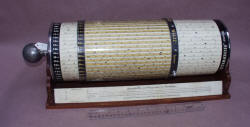 Loga
Drum Calculator / Sliderule This large
cylindrical slide rule / calculator is a Swiss idea that was produced just
after the turn of the century up until about 1920. They came in a few
different configurations and with different bases or covers. Note in the
other pics how it is able to swing up to be like a Fuller. This one has a
set of instructions on the base and a second revolving reference /
information area as seen in the bottom pic.
Loga
Drum Calculator / Sliderule This large
cylindrical slide rule / calculator is a Swiss idea that was produced just
after the turn of the century up until about 1920. They came in a few
different configurations and with different bases or covers. Note in the
other pics how it is able to swing up to be like a Fuller. This one has a
set of instructions on the base and a second revolving reference /
information area as seen in the bottom pic. Good+ . . . . .$1295.00 SOLD!
 The
Locke Adder This unusual sliding bar adder was patented in
Kensett Iowa in 1904. This is kind of late in the scheme of things as
far as the design of calculators and adders was progressing, and probably helps
explain its relative scarcity as it probably was not very popular and seemed
dated to potential buyers it was offered to. This example is in Good-
condition with some paint loss to the body. The slides all function as
they should. An interesting piece that clearly demonstrates just how far
we have come.
The
Locke Adder This unusual sliding bar adder was patented in
Kensett Iowa in 1904. This is kind of late in the scheme of things as
far as the design of calculators and adders was progressing, and probably helps
explain its relative scarcity as it probably was not very popular and seemed
dated to potential buyers it was offered to. This example is in Good-
condition with some paint loss to the body. The slides all function as
they should. An interesting piece that clearly demonstrates just how far
we have come.Good . . . . .$395.00 SOLD
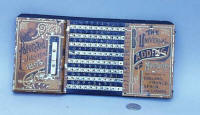 The
Universal Adder Patented July 15th 1890 This unusual sliding bar adder according
to the info on the front case was patented in England France Germany and Canada
as well as the US on the date found on the left side of the case. It was
a well done and interesting design, with a window in the back of the unit to
view the current result. The body is made of some sort o early plastic
/ gutta perch a type material, and it has warped somewhat over the years, making
sliding some of the scales a bit difficult to achieve. Overall the condition
is very nice otherwise. There is also remains of a label and instructions
on the back side as can be seen in the second picture.
The
Universal Adder Patented July 15th 1890 This unusual sliding bar adder according
to the info on the front case was patented in England France Germany and Canada
as well as the US on the date found on the left side of the case. It was
a well done and interesting design, with a window in the back of the unit to
view the current result. The body is made of some sort o early plastic
/ gutta perch a type material, and it has warped somewhat over the years, making
sliding some of the scales a bit difficult to achieve. Overall the condition
is very nice otherwise. There is also remains of a label and instructions
on the back side as can be seen in the second picture.
Good . . . . .$695.00 SOLD
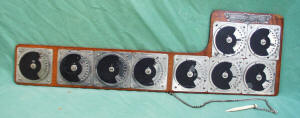 "Simplicitas"
Addizonartrice Despite its
name "Simplicitas" this adder is anything but simple and is as complicated an
adding machine as I have ever seen before. And I should note, I have never
seen this one before, and can find no mention of it running searches on
the internet or visiting several sites I know of that cover these pieces.
"Simplicitas"
Addizonartrice Despite its
name "Simplicitas" this adder is anything but simple and is as complicated an
adding machine as I have ever seen before. And I should note, I have never
seen this one before, and can find no mention of it running searches on
the internet or visiting several sites I know of that cover these pieces.
As can be seen it has 9 dials mounted on a nicely finished wooden board. It measures approx 22" long overall. It comes in the original fabric / faux leatherette case. Note there is one small ding in the top right corner of the back board. Overall it is very nice though. It has its original bone or ivory pointer as well.
The layout, with a single dial to the left, and then a group of 3, and then a group of 5 with 2 above 3, must mean something, to someone, but is beyond my reasoning capabilities. On top of that, each dial has 3 scales. 1-9 on the outside, then another 2 different scales under the wheel with one going into at least double digits. All of the dials are independent of each other and do not carry from one to the next. We need the instruction manual for this one, or you can spend a few minutes figuring it out.
Good . . . . .$1495.00 SOLD
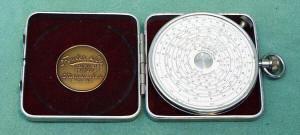 Fowler
Type H Calculator Fowler
is a well known English name in circular sliderules / calculators. This
Fowler pocket watch style calculator is in super like new condition. The
original instructions are nice and included. The outer box is tattered.
There is a small piece of plastic that was used as a magnifier. A very
nice example.
Fowler
Type H Calculator Fowler
is a well known English name in circular sliderules / calculators. This
Fowler pocket watch style calculator is in super like new condition. The
original instructions are nice and included. The outer box is tattered.
There is a small piece of plastic that was used as a magnifier. A very
nice example.
Good . . . . .$295.00 SOLD
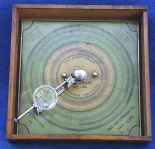 The
Hart Calculator or Equationor I can
barely use some of the simple examples of these calculating marvels from an
earlier time that I have had, and I routinely use to flunk most of the
math courses that I had to take in school, but there must be a latent
gene that drives the quest as I cannot seem to stop buying these sort of things.
Vintage calculators, slide rules, and other calculation devices are still available
and it is always fun to find a different one while on the hunt.
The
Hart Calculator or Equationor I can
barely use some of the simple examples of these calculating marvels from an
earlier time that I have had, and I routinely use to flunk most of the
math courses that I had to take in school, but there must be a latent
gene that drives the quest as I cannot seem to stop buying these sort of things.
Vintage calculators, slide rules, and other calculation devices are still available
and it is always fun to find a different one while on the hunt.
SOLD
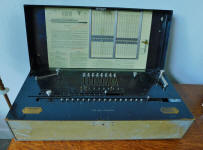 Millionaire Calculator
- Calculating Machine The idea for the Millionaire Calculator design was first patented in 1892 by Otto Steiger of Munich Germany. Steiger's
design was later improved upon by Hans W. Egli of Zurich Switzerland. The
tag on the left side of this example has the Egli name. This example
is also marked with two US patent dates from 1895. Production of
the Millionaire Calculator began in 1893 and ended in 1935.
A total of about five thousand were manufactured. From the serial # 1633 we
can assume this example dates from just after the turn of the century. There is an online registry for these
calculating machines found at John Wolff's Web Museum / Register of Millionaire Calculators. He has a number of examples listed,
(over 200) and many examples are pictured there.
Millionaire Calculator
- Calculating Machine The idea for the Millionaire Calculator design was first patented in 1892 by Otto Steiger of Munich Germany. Steiger's
design was later improved upon by Hans W. Egli of Zurich Switzerland. The
tag on the left side of this example has the Egli name. This example
is also marked with two US patent dates from 1895. Production of
the Millionaire Calculator began in 1893 and ended in 1935.
A total of about five thousand were manufactured. From the serial # 1633 we
can assume this example dates from just after the turn of the century. There is an online registry for these
calculating machines found at John Wolff's Web Museum / Register of Millionaire Calculators. He has a number of examples listed,
(over 200) and many examples are pictured there.
The Millionaire calculator was the first commercially successful mechanical calculator that could perform direct multiplication. Other calculating machines of the period were adding machines that accomplished multiplication by preforming addition calcs over and over. A much slower process. This aspect of the design is explained in great detail at the www.history-computer.com site. The tag on the left indicates this example was sold here in the US. The tag reads W. A. Morschhauser Sole Agent Madison Ave New York City. I read these machines retailed for between $475.00 and $1100.00 at the time of manufacture. A huge sum for the time.
Note the exceptional condition. This Antique Millionaire Calculator shows very little signs of use and mainly just storage scuffs. This is the less common metal case model. The Millionaire Calculator also came in wooden cases. Overall It is in very nice condition with typical scratches. On the interior, the areas under the swinging arms still have nearly all of the original black finish. Many examples you can view online show considerable wear in these areas. It is a large and heavy machine. The measurements are approx. 7 1/4" x 25 5/8" x 11 1/4". It weighs close to 70 lbs. and is the 8 column model. They could be had in larger sizes with up to 12 columns. A rare opportunity to own a piece of calculation history. Recommended.
Fine . . . . . $2450.00 SOLD!!
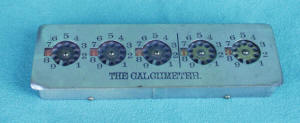 The
Calcumeter This is the smallest
5 place model of this patented adder. These are 10 times harder to find
than the larger models. It is in very nice condition noting one bent corner.
The
Calcumeter This is the smallest
5 place model of this patented adder. These are 10 times harder to find
than the larger models. It is in very nice condition noting one bent corner.
Good . . . . .$195.00 SOLD
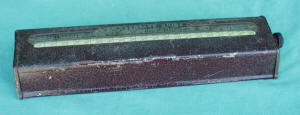 Percentage Calculator
These are usually associated with stores where the operator was trying
to figure out his profit or discount to be given. This one is Tole
Painted and probably dates from just after the turn of the century from
the look of it.
Percentage Calculator
These are usually associated with stores where the operator was trying
to figure out his profit or discount to be given. This one is Tole
Painted and probably dates from just after the turn of the century from
the look of it.
Good+ . . . . .$125.00 SOLD
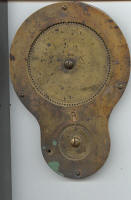 1st
Model Webb Patent Adder The Webb
Patent Adding Machine came in 2 different models with this the brass
version mounted on a mahogany board the first and earliest model.
Later versions were brass that was nickel plated. This is
properly marked with the patent date, and the serial #.
1st
Model Webb Patent Adder The Webb
Patent Adding Machine came in 2 different models with this the brass
version mounted on a mahogany board the first and earliest model.
Later versions were brass that was nickel plated. This is
properly marked with the patent date, and the serial #.
Good . . . . .$895.00 SOLD
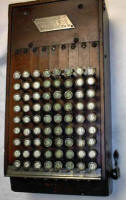 1st
Model Comptometer / Adding Machine The
Comptometer was a huge success and the later models are considered quite
common. These earlier version in the wooden case are quite hard to
find, and entire websites have been set up to provide, and gather
information about them. There is a site where you can register
early ones like this, and just a fraction of those made have been
documented. This is a nice one and an opportunity not to be
missed.
1st
Model Comptometer / Adding Machine The
Comptometer was a huge success and the later models are considered quite
common. These earlier version in the wooden case are quite hard to
find, and entire websites have been set up to provide, and gather
information about them. There is a site where you can register
early ones like this, and just a fraction of those made have been
documented. This is a nice one and an opportunity not to be
missed.
Good . . . . .$2495.00 SOLD
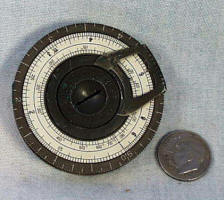 "Small"
Pocket Calculator / Slide Rule This
unusual slide rule / calculator was patented, but there was only
one production run and few of those were sold until a stash of them was
found back in the 70's or early 80's. That small stash was qu9ckly
gobbled up and they are rarely seen now that the limited supply has been
distributed. This is a nice one.
"Small"
Pocket Calculator / Slide Rule This
unusual slide rule / calculator was patented, but there was only
one production run and few of those were sold until a stash of them was
found back in the 70's or early 80's. That small stash was qu9ckly
gobbled up and they are rarely seen now that the limited supply has been
distributed. This is a nice one.
Good + . . . . .$695.00 SOLD
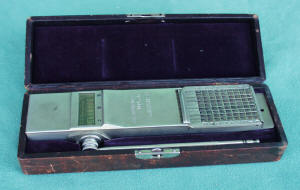 The
Rapid" Calculator / Adder This is a very complicated
and precision made adder / calculator. I have only had a few over the last
20 years. I know firsthand as my last one had a small problem carrying over,
and after I got inside, and started taking it apart, I regretted it. I am
sure I voided the warranty on that one. This example is near mint and operates
just fine. Personally though, I would buy an electronic hand held for a 1.00
and leave this one for display.
The
Rapid" Calculator / Adder This is a very complicated
and precision made adder / calculator. I have only had a few over the last
20 years. I know firsthand as my last one had a small problem carrying over,
and after I got inside, and started taking it apart, I regretted it. I am
sure I voided the warranty on that one. This example is near mint and operates
just fine. Personally though, I would buy an electronic hand held for a 1.00
and leave this one for display.
Good+ . . . . .$295.00 SOLD!
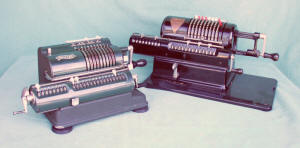 Marchant
Calculator
The Marchant Calculator
company was based in Oakland Ca and began operation near the turn of the century
with their non-electric pin wheel design calculators that are well known and highly
collectible. The Marchant in the Click for Pic is the black one on the right.
The condition is excellent. The label on the back lists off all the different
Patents that were designed to protect it, but Marchant is but one of the names associated
with this design, so they were either selling the rights, or they were in production
for a long enough time for copies to be made. As the technology grew
they moved on to electric models. This earlier model is in very nice condition
and seems to be fully operational.
Marchant
Calculator
The Marchant Calculator
company was based in Oakland Ca and began operation near the turn of the century
with their non-electric pin wheel design calculators that are well known and highly
collectible. The Marchant in the Click for Pic is the black one on the right.
The condition is excellent. The label on the back lists off all the different
Patents that were designed to protect it, but Marchant is but one of the names associated
with this design, so they were either selling the rights, or they were in production
for a long enough time for copies to be made. As the technology grew
they moved on to electric models. This earlier model is in very nice condition
and seems to be fully operational.
Good+ . . . . .$195.00 SOLD!
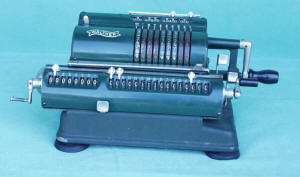 Walther
Calculator The German Walther company
was best known for manufacturing weapons and pistols. In 1926 they branched
out to include a line of calculators. The condition of this example is very
nice looking but it is jammed up.
Walther
Calculator The German Walther company
was best known for manufacturing weapons and pistols. In 1926 they branched
out to include a line of calculators. The condition of this example is very
nice looking but it is jammed up.
Good . . . . .$225.00 SOLD!
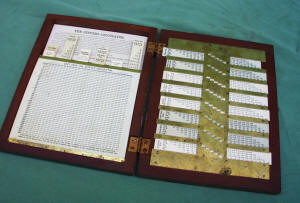 "The
Jeffers" Calculator This is a very
unusual and complex Agricultural related calculator. It is in super near unused
condition. It is a wooden box that opens to reveal the calculator inside.
It measures approx 5 x7". Inside the front door on the left side are the instructions
and explanation of what you would need this for and how to use it. Basically
it is for computing just the right mixtures of feed and ingredients for livestock
nutrition derived from different ratios of mixtures of different grains and meals.
Sound complicated, just try using it to see how tedious it is.
I think that pretty much explains the condition, as I would be willing to bet most
of the livestock got whatever was available in the way of leftovers from the corn
crop or other grain crops, and that was pretty much it. There must be
60-70 different printed slides stored on the left which you would put into the holders
on the right, and start computing the ratios, cost, weight and so forth. I
have a feeling this did not go over real big with the typical country farmer, and
back then, when the farms were pretty much family owned something like this was
not really needed or desired. Perhaps today, and perhaps the Chinese should
be using something like it before they add to much of whatever to the next batch
of dog food, or your food.
"The
Jeffers" Calculator This is a very
unusual and complex Agricultural related calculator. It is in super near unused
condition. It is a wooden box that opens to reveal the calculator inside.
It measures approx 5 x7". Inside the front door on the left side are the instructions
and explanation of what you would need this for and how to use it. Basically
it is for computing just the right mixtures of feed and ingredients for livestock
nutrition derived from different ratios of mixtures of different grains and meals.
Sound complicated, just try using it to see how tedious it is.
I think that pretty much explains the condition, as I would be willing to bet most
of the livestock got whatever was available in the way of leftovers from the corn
crop or other grain crops, and that was pretty much it. There must be
60-70 different printed slides stored on the left which you would put into the holders
on the right, and start computing the ratios, cost, weight and so forth. I
have a feeling this did not go over real big with the typical country farmer, and
back then, when the farms were pretty much family owned something like this was
not really needed or desired. Perhaps today, and perhaps the Chinese should
be using something like it before they add to much of whatever to the next batch
of dog food, or your food.
I looked it over, and tried it out, and I can confirm it is pretty much non understandable. That is what makes it a great collectible in the field of calculation.
Excellent . . . . .$195.00 SOLD!!
"The Locke Adder" This unusual sliding bar adder / calculator was patented in Kensett Iowa in 1901. These unusual adding machines can be found marked with a second patent date from 1905 as well, and so I assume we can call this the first model.
This adder seems kind simplistic in the scheme of things as the design of calculators and adders had been progressing rapidly and was well advanced past this design by 1900, but I guess they had not heard that in outer Iowa and about what was going on in the rest of the world. This probably helps explain its relative scarcity as it probably was not very popular outside of that area and seemed dated to potential buyers elsewhere it was offered to. That old world view probably explains some of the goings on in Iowa today as well.
This example is in excellent condition and show little signs of wear or tear. The main body is pressed steel in a copper flash finish, and the sliding adding bars have nearly all of their original paint. The slides all function as they should. An interesting piece that clearly demonstrates just how far the field of calculation has come and how Iowa fits into the picture.
Good . . . . .$495.00 SOLD!!
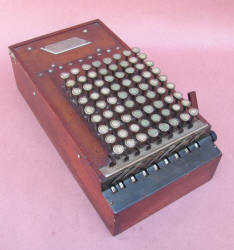 1st Model Wooden Case "ShoeBox" Comptometer
Adder / Calculator The serial # on
this 1st model Comptometer is 2190. It is stamped into the metal cover
over the counter area near the middle. These early wooden case
comptometers
were offered beginning in 1887 and were sold through 1903. During that period a little over
6,000 were produced. After that the machine was cased in a metal
housing. The basic idea remained pretty much the same while going through a number of
minor cosmetic changes over the years.
1st Model Wooden Case "ShoeBox" Comptometer
Adder / Calculator The serial # on
this 1st model Comptometer is 2190. It is stamped into the metal cover
over the counter area near the middle. These early wooden case
comptometers
were offered beginning in 1887 and were sold through 1903. During that period a little over
6,000 were produced. After that the machine was cased in a metal
housing. The basic idea remained pretty much the same while going through a number of
minor cosmetic changes over the years. There is a very informative and worthwhile site that details the history, design, operation, and other info about these machines on the internet. It can be found at www2.cruzio.com . This 1st Model Comptometer is listed there along with the other known wood case examples that have turned up. Known wood case models number under 100 according to this chart. This example came from at descendant of the original inventor / maker whose name was Felt.
All of the main keys seem to operate as they should. There are none that are stuck. By manipulating the key strokes I can get it to zero out, but the black knob on the side which is supposed to zero it does not turn or operate. The wooden return lever moves but does not seem to do anything. In general when pushing the main keys it seems to carry over pretty good, except for the last column which seems to skip or overcount at times. The main parts of the case are in Mahogany and the base appears to be a softwood like pine. The outer case is in very nice condition and looks to be original finish. The bottom cover door is missing. A new panel could easily be fabricated if wanted. These wooden case comptometers only appear on the market occasionally. Some have been known to sell in the $4000 - $6000 range, and we have this one priced to reflect the minor operational issues mentioned above. A rare piece that will be a welcome addition to the advanced collection of early American calculation devices
Good . . . . .$1295.00 SOLD!!
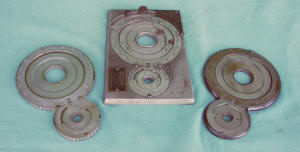 Three
Different Webb Adder / Calculators The Webb adder was first patented
near the turn of the century. The first models were brass and mounted on a
wooden board. The next generation looked like the one on the left. After
that other versions appeared such as the Herring Calculator in the middle.
These were designed to calculator / add weights or loads of rail cars.
It is a hard to find variation of this calculator. Finally on the right we
have what has become the norm in our lives, an unmarked knockoff that was offered
at the time as the real thing. . Much like most of the name brand stuff
you see at flea markets today, unless of course the parent company moved production
there, then it is called progress or Global something. It does not add up.
Anyway, all three of these are pretty nice, and all seem to operate. Fill
out the collection.
Three
Different Webb Adder / Calculators The Webb adder was first patented
near the turn of the century. The first models were brass and mounted on a
wooden board. The next generation looked like the one on the left. After
that other versions appeared such as the Herring Calculator in the middle.
These were designed to calculator / add weights or loads of rail cars.
It is a hard to find variation of this calculator. Finally on the right we
have what has become the norm in our lives, an unmarked knockoff that was offered
at the time as the real thing. . Much like most of the name brand stuff
you see at flea markets today, unless of course the parent company moved production
there, then it is called progress or Global something. It does not add up.
Anyway, all three of these are pretty nice, and all seem to operate. Fill
out the collection.
Left ..... Good+ . . . .$295.00 SOLD!
Middle ..... Good+ . . . . .$395.00 SOLD!
Right ..... Good+ . . . . .$225.00 SOLD!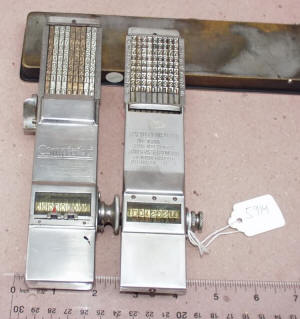 Comptator
Calculator / Adder These two are basically the same with different
makers names. The left one is German and has location info on the front.
Comptator
Calculator / Adder These two are basically the same with different
makers names. The left one is German and has location info on the front.
"The Rapid Computer" Calculator / Adder The writing on this one says it was patented in the US in 1892. It says it hails from Benton Harbor MI. It seems to work just fine. Very Nice!!
Left ...... Comptator ..... Excellent .....$95.00 SOLD!
Right .... The Rapid Computer .....Excellent .....$75.00 SOLD!
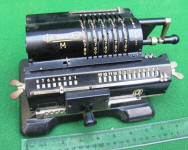 Odhner
Style Mechanical Calculator
This mechanical calculator is similar in design and function to the American
Marchant mechanical calculators made in Oakland CA around the beginning of
the 20th century. The name on this example looks to be Russian or
some other Cyrillic language and it may be an Odhner which have similar
features like the wingnut zeroing knobs this one sports. Odhner
calculators were first made in Russia in the 1870's after which production
was moved to Sweden. There are many other brands or makes of
mechanical calculators similar to this as it was a popular design that was
produced worldwide well into the 20th century. It is functional and
not bound up or jammed. The overall condition is very nice!!
Odhner
Style Mechanical Calculator
This mechanical calculator is similar in design and function to the American
Marchant mechanical calculators made in Oakland CA around the beginning of
the 20th century. The name on this example looks to be Russian or
some other Cyrillic language and it may be an Odhner which have similar
features like the wingnut zeroing knobs this one sports. Odhner
calculators were first made in Russia in the 1870's after which production
was moved to Sweden. There are many other brands or makes of
mechanical calculators similar to this as it was a popular design that was
produced worldwide well into the 20th century. It is functional and
not bound up or jammed. The overall condition is very nice!!Fine . . . . . .$95.00 SOLD!!
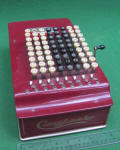 Comptometer Mechanical Calculator
This mechanical Comptometer calculator was cosmetically restored and sold by
This Olde Office an outfit that dealt in Antique office equipment that was based here in CA back in the 90's. The owner bought old used office
equipment and repainted and "restored" them creating antiques for the
decorating crowd not only in CA but worldwide. It looks great, but
this vibrant color is not one used buy the actual company.
Interesting.
Comptometer Mechanical Calculator
This mechanical Comptometer calculator was cosmetically restored and sold by
This Olde Office an outfit that dealt in Antique office equipment that was based here in CA back in the 90's. The owner bought old used office
equipment and repainted and "restored" them creating antiques for the
decorating crowd not only in CA but worldwide. It looks great, but
this vibrant color is not one used buy the actual company.
Interesting.Fine . . . . . .$15.00 SOLD!!
 Burroughs
Glass Side Adding Machine / Calculator
Without a doubt the Burroughs Adding Machine is one of the most graphic if
not heaviest of all 10 key adders / calculators ever made. This one
looks great with its see through glass sides so one could / can see how the
mechanism worked when operated. The stand is original and nice.
Quite impressive! It was restored / repainted
and sold by This Olde Office which was located here in CA back in the 90's.
It comes complete with a framed letter of authenticity which authoritatively
and definitively
guarantees that this is in fact an adding machine. Thor did nice work.
A great reminder of what it use to be like.
Nice!!
Burroughs
Glass Side Adding Machine / Calculator
Without a doubt the Burroughs Adding Machine is one of the most graphic if
not heaviest of all 10 key adders / calculators ever made. This one
looks great with its see through glass sides so one could / can see how the
mechanism worked when operated. The stand is original and nice.
Quite impressive! It was restored / repainted
and sold by This Olde Office which was located here in CA back in the 90's.
It comes complete with a framed letter of authenticity which authoritatively
and definitively
guarantees that this is in fact an adding machine. Thor did nice work.
A great reminder of what it use to be like.
Nice!!Good + . . . . . .$195.00 SOLD!!
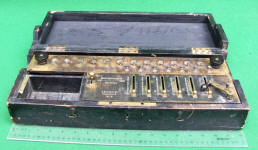 A. Burkhardt Type A Arithmometer
This early
stepped drum adder / calculator is in nice overall condition. From its
features and low # 72 serial number It would be a first model called the Model A produced in the 1870's. The basic design of this style calculator was first designed
over 100 years earlier and there are numerous bios on the inventors and histories of this
style stepped drum calculator called and Arithmometer that can be found on the internet. I
read the original
design was developed by Liebniz. Mathias Hahn & Thomas de Colmar created
versions of their own design after Liebniz. A. Burkhardt was German and is
credited with being the first in Germany to produce them. Over the
years he produced several different models with this style being the
earliest. This same basic design calculator can be found with several
other names from different locals as well.
A. Burkhardt Type A Arithmometer
This early
stepped drum adder / calculator is in nice overall condition. From its
features and low # 72 serial number It would be a first model called the Model A produced in the 1870's. The basic design of this style calculator was first designed
over 100 years earlier and there are numerous bios on the inventors and histories of this
style stepped drum calculator called and Arithmometer that can be found on the internet. I
read the original
design was developed by Liebniz. Mathias Hahn & Thomas de Colmar created
versions of their own design after Liebniz. A. Burkhardt was German and is
credited with being the first in Germany to produce them. Over the
years he produced several different models with this style being the
earliest. This same basic design calculator can be found with several
other names from different locals as well. This example wants to work, but does not work properly or consistently. I believe it is just an adjustment. I see do damage, bent pins, missing parts or the like on the underside. It will work for small amounts, and sometimes for larger ones, but then will hang up. It zeros out and the carriage moves OK. Also the division function works - - - - sometimes. On the left the small framed slate board is missing over the open hole. There are also 2 of the miniature thumbscrews missing from the first two digits on the upper far left. You can see this in the pics.
A rare and unusual calculating machine, especially being the early model with such a low serial number. Worthy of inclusion in any collection with a focus on Office antiques, calculation, or technology advancement.
Good . . . . .$1995.00 SOLD!!
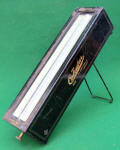 The
Calculus Calculator This is a calculator I have never seen or had before. This unusual dial / drum type calculator claims it was
patented on January 22nd 1907. It also has the maker name James J.
Hinde Co. of Cleveland O. on the side. The catchy logo / phrase under
the name reads "Proves as it Calculates".
The
Calculus Calculator This is a calculator I have never seen or had before. This unusual dial / drum type calculator claims it was
patented on January 22nd 1907. It also has the maker name James J.
Hinde Co. of Cleveland O. on the side. The catchy logo / phrase under
the name reads "Proves as it Calculates".I could not find the patent with Google Patent Search. I did find an ad in a lumberman's magazine touting it usefulness for use in that field or trade. A few other references to this calculator can be found on the internet, but scant examples are pictured or discussed. The internet site that deals with office antiques like pencil sharpeners, staplers, and the like also has an ad for one of these showing the user sitting in front of a larger and what looks to be ganged together unit. The dimensions of this stand alone Calculus Calculator unit are 4 x 5 x 18". Note the folding leg / stand that angles it for easy use.
It looks as if it is meant to calculate the price of multiple units. The rotating drum is broken down into 1/4 increments starting at one and going up to 80, or maybe 100. The columns are the top number added to itself over and over again in different ways A lot of it makes no sense to me, and I have provided numerous pics below to help you determine just what it is capable of doing. Different!!
Good +. . . . . $795.00 SOLD!
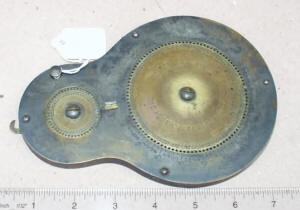 1st
Model Webb Adder / Calculator The Webb Adder was first patented
near the turn of the century and the first model had a brass face and mahogany back
as seen here. They were also marked with a serial # and this one is # A-5664.
The next generation were all metal and nickel plated like the ones just below.
The patina on this one is great, and it seems to operate just fine and does carry.
The earlier versions are becoming very difficult to find, hardly ever offered for
sale and this is a great looking specimen. Very Nice!!
1st
Model Webb Adder / Calculator The Webb Adder was first patented
near the turn of the century and the first model had a brass face and mahogany back
as seen here. They were also marked with a serial # and this one is # A-5664.
The next generation were all metal and nickel plated like the ones just below.
The patina on this one is great, and it seems to operate just fine and does carry.
The earlier versions are becoming very difficult to find, hardly ever offered for
sale and this is a great looking specimen. Very Nice!!
Good+ . . . . .$695.00 SOLD!
 1st
Model Wooden Case / Shoe Box Style Comptometer w/ Fractional Keys
The serial # on this 1st model Comptometer w/ fractional keys is 5539. It
is stamped into the metal cover over the counter area between the 4th and
5th window. These early 1st model wooden case comptometers were offered
beginning in 1887 and were sold through 1903. During that period a little
over 6,000 were produced. After that the machine was cased in a metal
housing. The basic idea remained pretty much the same while going through a
number of minor cosmetic changes over the years.
1st
Model Wooden Case / Shoe Box Style Comptometer w/ Fractional Keys
The serial # on this 1st model Comptometer w/ fractional keys is 5539. It
is stamped into the metal cover over the counter area between the 4th and
5th window. These early 1st model wooden case comptometers were offered
beginning in 1887 and were sold through 1903. During that period a little
over 6,000 were produced. After that the machine was cased in a metal
housing. The basic idea remained pretty much the same while going through a
number of minor cosmetic changes over the years. There is a very informative and worthwhile site that details the history, design, operation, and other info about these machines on the internet. It can be found at www2.cruzio.com . This 1st Model Comptometer is not listed there with the other known wood case examples that have turned up. Known wood case models number under 100 according to this chart and just a couple have fractional keys.Doing the math, it can be assumed that one, very few comptometers were made with fractional keys, and 2, that even fewer have survived.
All of the main keys seem to operate as they should. There are none that are stuck. By manipulating the key strokes I can get it to zero out. Beyond that it is not tested. The main parts of the case are in Mahogany with its original crusty finish. The base appears to be a softwood like pine and the bottom door is present.
These wooden case comptometers only appear on the market occasionally. Some have been known to sell in the $4000 - $6000 range. This 1st model fractional key comptometer is rare piece that will be a welcome addition to the advanced collection of early American calculation devices. Very Nice!!
Good + . . . . .$4500.00 SOLD!
 Pickett
N500-ES 4' Classroom Teaching Aid Slide Rule The
condition of this 4' teaching aid sliderule is very nice. It is
model # N500-ES Log Log rule and has 22 scales. It dates from the 1960's. Nice!!
Pickett
N500-ES 4' Classroom Teaching Aid Slide Rule The
condition of this 4' teaching aid sliderule is very nice. It is
model # N500-ES Log Log rule and has 22 scales. It dates from the 1960's. Nice!!Fine . . . . . $350.00
 Pickett
N1010-ES Trig 7' Classroom Teaching Aid Slide Rule The
condition of this 7' teaching aid sliderule is very nice. It is
model # N01010-ES Trig rule. It dates from the 1960's or 70's. I do
not think it was ever used. Nice!!
Pickett
N1010-ES Trig 7' Classroom Teaching Aid Slide Rule The
condition of this 7' teaching aid sliderule is very nice. It is
model # N01010-ES Trig rule. It dates from the 1960's or 70's. I do
not think it was ever used. Nice!!Fine . . . . . $350.00 SOLD!!
This is just a sample of the many
antiques & collectibles we have sold.
Click link to see other
Sales Archive Pages on this Site.
We Buy Quality Office & Scientific Related
Antiques
Contact Us at
AntiqBuyer@gmail.com
Our current offering of Antiques for sale are at our sister Website Patented-Antiques.com.